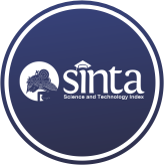Enhancing Riverine Water Quality Prediction: The Application of Variational Autoencoders for Robust Data Augmentation in Environmental Science
(1) Universitas Katolik Indonesia Atma Jaya, Indonesia
(*) Corresponding Author
Abstract
Full Text:
PDFReferences
Y. Huang et al., “Forward-looking roadmaps for long-term continuous water quality monitoring: bottlenecks, innovations, and prospects in a critical review,” Environ. Sci. & Technol., vol. 56, no. 9, pp. 5334–5354, 2022.
S. Khullar and N. Singh, “Water quality assessment of a river using deep learning Bi-LSTM methodology: forecasting and validation,” Environ. Sci. Pollut. Res., vol. 29, no. 9, pp. 12875–12889, 2022.
L. M. Kuehne et al., “The future of global river health monitoring,” PLOS Water, vol. 2, no. 9, p. e0000101, 2023.
C. Xu, X. Chen, and L. Zhang, “Predicting river dissolved oxygen time series based on stand-alone models and hybrid wavelet-based models,” J. Environ. Manage., vol. 295, p. 113085, 2021.
Y. Liu, Q. Zhang, L. Song, and Y. Chen, “Attention-based recurrent neural networks for accurate short-term and long-term dissolved oxygen prediction,” Comput. Electron. Agric., vol. 165, p. 104964, 2019.
H. Guo et al., “A generalized machine learning approach for dissolved oxygen estimation at multiple spatiotemporal scales using remote sensing,” Environ. Pollut., vol. 288, p. 117734, 2021.
S. Luo et al., “FREE: The Foundational Semantic Recognition for Modeling Environmental Ecosystems,” arXiv Prepr. arXiv2311.10255, 2023.
H. Li, C. Qin, W. He, F. Sun, and P. Du, “Improved predictive performance of cyanobacterial blooms using a hybrid statistical and deep-learning method,” Environ. Res. Lett., vol. 16, no. 12, p. 124045, 2021.
M. Sonnewald, R. Lguensat, D. C. Jones, P. D. Dueben, J. Brajard, and V. Balaji, “Bridging observations, theory and numerical simulation of the ocean using machine learning,” Environ. Res. Lett., vol. 16, no. 7, p. 73008, 2021.
S. Zhong et al., “Machine learning: new ideas and tools in environmental science and engineering,” Environ. Sci. & Technol., vol. 55, no. 19, pp. 12741–12754, 2021.
D. Iskandaryan, F. Ramos, and S. Trilles, “Air quality prediction in smart cities using machine learning technologies based on sensor data: a review,” Appl. Sci., vol. 10, no. 7, p. 2401, 2020.
W. Wei, O. Ramalho, L. Malingre, S. Sivanantham, J. C. Little, and C. Mandin, “Machine learning and statistical models for predicting indoor air quality,” Indoor Air, vol. 29, no. 5, pp. 704–726, 2019.
W. Wu, R. Emerton, Q. Duan, A. W. Wood, F. Wetterhall, and D. E. Robertson, “Ensemble flood forecasting: Current status and future opportunities,” Wiley Interdiscip. Rev. Water, vol. 7, no. 3, p. e1432, 2020.
A. J. Lopatkin and J. J. Collins, “Predictive biology: modelling, understanding and harnessing microbial complexity,” Nat. Rev. Microbiol., vol. 18, no. 9, pp. 507–520, 2020.
F. Couvreux et al., “Process-based climate model development harnessing machine learning: I. A calibration tool for parameterization improvement,” J. Adv. Model. Earth Syst., vol. 13, no. 3, p. e2020MS002217, 2021.
J. Houston, F. G. Glavin, and M. G. Madden, “Robust classification of high-dimensional spectroscopy data using deep learning and data synthesis,” J. Chem. Inf. Model., vol. 60, no. 4, pp. 1936–1954, 2020.
R. Tang, “Some advances in Bayesian inference and generative modeling,” University of Illinois at Urbana-Champaign, 2023.
T. Glüsenkamp, “Unifying supervised learning and VAEs--automating statistical inference in (astro-) particle physics with amortized conditional normalizing flows,” arXiv Prepr. arXiv2008.05825, 2020.
A. De Vos, R. Biggs, and R. Preiser, “Methods for understanding social-ecological systems: a review of place-based studies,” Ecol. Soc., vol. 24, no. 4, 2019.
DOI: https://doi.org/10.30645/kesatria.v5i1.328
DOI (PDF): https://doi.org/10.30645/kesatria.v5i1.328.g325
Refbacks
- There are currently no refbacks.
Published Papers Indexed/Abstracted By:














